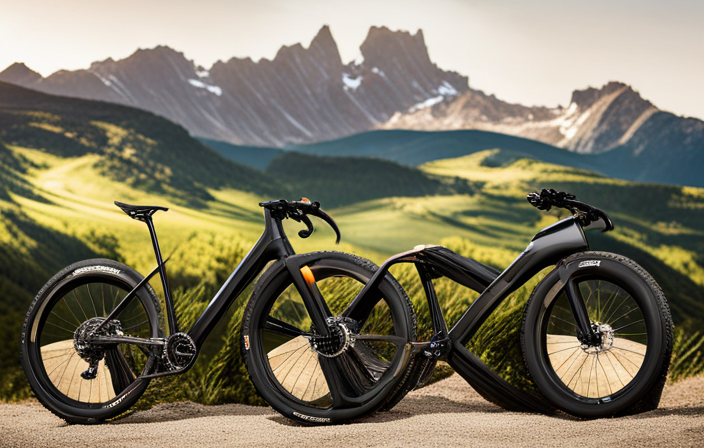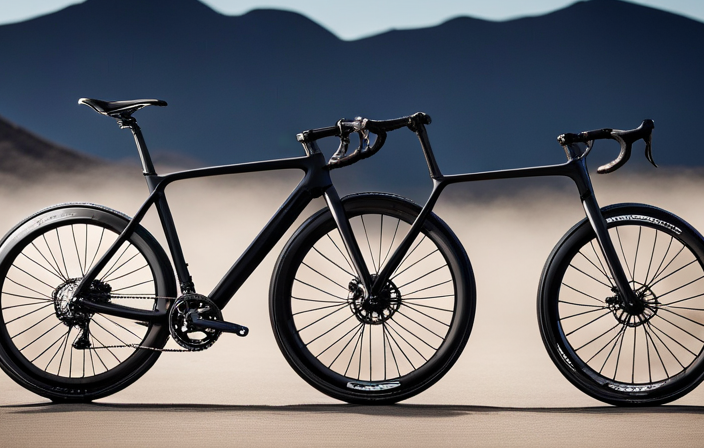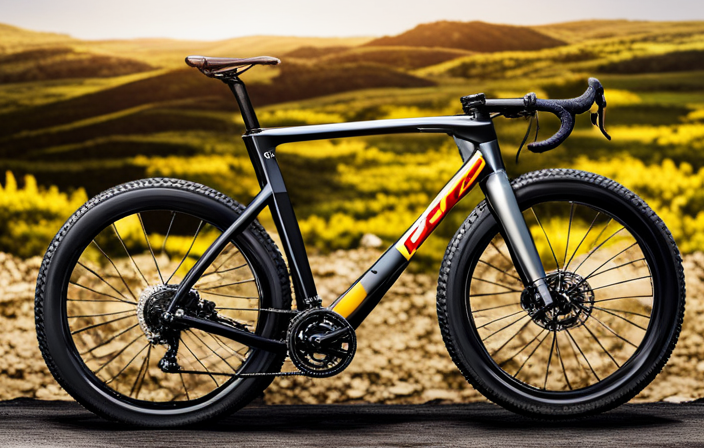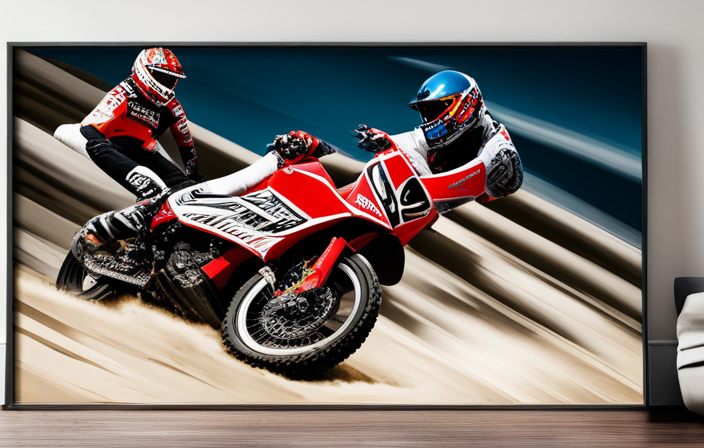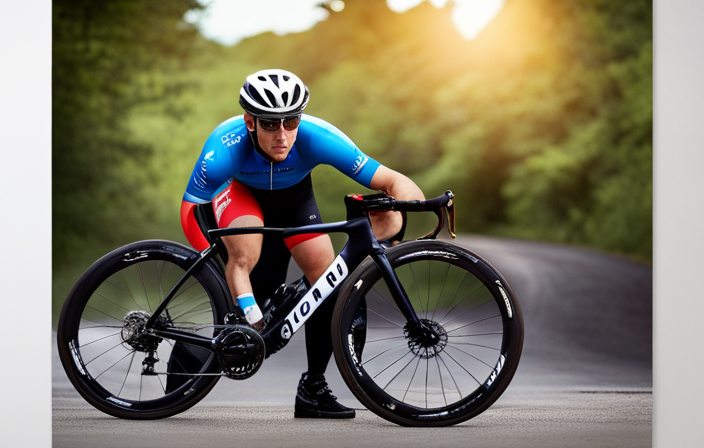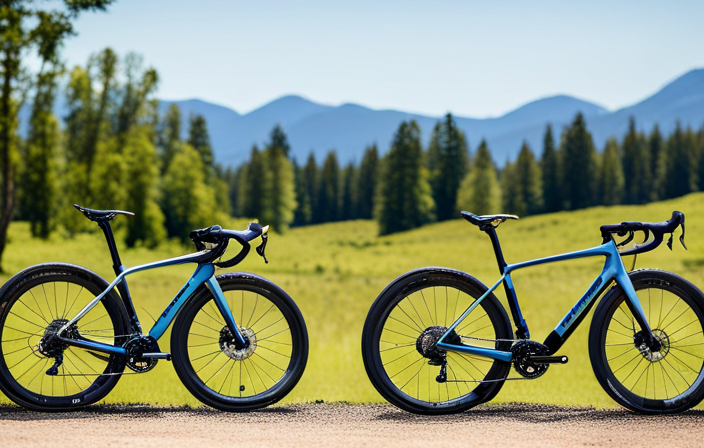Were you aware that gravel biking is becoming increasingly popular, quickly rising to be a leading category within the cycling market?
With its ability to handle a variety of terrains, gravel bikes have become increasingly popular among cyclists of all skill levels.
In this article, I will explore what makes a gravel bike so versatile and why it is good for various types of rides.
From tackling gravel trails with ease to exploring off-road adventures and scenic routes, there’s no limit to the possibilities with a gravel bike.
So, let’s dive in and discover the exciting world of gravel biking!
Key Takeaways
- Gravel bikes are versatile and can handle various terrains, making them perfect for off-road adventures, bikepacking, long-distance rides, and comfortable commuting.
- They offer freedom on different surfaces like pavement and gravel roads, allowing riders to switch between different types of terrain easily.
- Gravel bikes excel in gravel bike races with their stability and speed, making them a popular choice for competitive riders.
- Factors to consider when choosing a gravel bike include frame material, tire clearance, and gearing options, ensuring the bike meets the specific needs of the rider.
Introduction to Gravel Bikes
A gravel bike is perfect for riders who want a versatile and capable bicycle. Gravel biking has gained popularity in recent years due to its ability to handle various terrains and provide an exciting riding experience.
One of the pros of gravel biking is the freedom it offers on different surfaces, including pavement, gravel roads, and even off-road trails. This versatility allows riders to explore new routes and enjoy different types of terrain without limitations.
However, like any other type of cycling, there are cons to consider as well. Gravel bikes tend to be heavier compared to road bikes, which may affect speed on smoother surfaces. Additionally, they may not be as efficient for long-distance rides due to their wider tires and more relaxed geometry.
Choosing the right gravel bike for your needs is crucial. Factors such as frame material, tire clearance, gearing options, and overall fit should be considered when making a decision. Aluminum frames offer durability at a lower cost while carbon frames provide a lighter option with increased comfort. Tire clearance determines the maximum width that can fit on your bike, allowing for better traction on loose surfaces. Gearing options are essential depending on the type of terrain you plan to ride.
With its pros and cons in mind, let’s dive into the next section about the versatility of gravel bikes on different terrains without compromising performance or comfort.
Versatility on Different Terrains
Versatility on different terrains is enhanced by the ability of gravel bikes to handle various types of surfaces. One key feature that contributes to their versatility is the improved suspension system. Gravel bikes are designed with suspension forks and seat posts, which provide better shock absorption and make riding on rough terrains more comfortable. This means that whether you’re navigating through bumpy roads or tackling gravel trails, a gravel bike can handle it with ease.
Not only are these bikes capable of handling different surfaces, but they also excel in gravel bike races. These races typically take place on mixed terrain, including paved roads, dirt paths, and gravel trails. Gravel bikes are built specifically for this type of racing, offering a perfect balance between speed and stability. The wider tires provide excellent traction on loose surfaces like gravel or dirt, while still allowing for efficient rolling on smoother sections.
With their improved suspension and race-ready design, gravel bikes allow riders to tackle any kind of terrain with confidence and ease. In the next section, we will delve into how these bikes navigate through challenging gravel trails effortlessly without compromising performance or comfort.
Tackling Gravel Trails with Ease
Navigating through challenging gravel trails effortlessly is made possible by the advanced suspension system and race-ready design of gravel bikes. These specialized bicycles are equipped with features that enhance their performance on rough terrains, allowing riders to tackle gravel trails with ease.
Here are five reasons why gravel bikes excel in this terrain:
- Stability: The wide tires provide excellent traction, ensuring stability even on loose surfaces.
- Comfort: Gravel bikes come with a more relaxed geometry and additional tire clearance, reducing vibrations and bumps for a smoother ride.
- Durability: Built to withstand harsh conditions, gravel bikes are designed with robust frames and components that can handle the demands of off-road riding.
- Versatility: Gravel bikes offer the ability to switch between different types of terrain easily, from smooth pavement to rugged dirt paths.
- Adventure: Riding a gravel bike opens up a world of exploration as it allows you to discover new off-road routes and experience nature like never before.
With these benefits in mind, riding a gravel bike provides an exhilarating experience on gravel trails while also offering the versatility to venture into other off-road adventures.
Exploring Off-Road Adventures
When you’re ready to hit the trails, there’s no better way to experience the thrill of off-road adventures than exploring with a gravel bike. Gravel bikes are designed to handle a variety of terrains, making them perfect for exploring off-road trails and embarking on exciting bikepacking adventures. With their sturdy construction and versatile features, these bikes allow you to go beyond the paved roads and discover new destinations.
To fully enjoy your off-road adventures, it’s essential to have the right gear and equipment. When going on long-distance rides or bikepacking trips, make sure you have all the necessary bikepacking essentials like a lightweight tent, sleeping bag, cooking stove, and repair tools. These items will ensure that you’re prepared for any situation that may arise during your adventure.
When it comes to choosing the best gravel bike for your off-road escapades, there are several top brands known for their quality and performance. Some popular options include Specialized, Trek, Giant, and Cannondale. These brands offer a wide range of gravel bikes with different features and specifications to suit various riding styles.
As we transition into discussing bikepacking and long-distance rides in the next section about ‘bikepacking essentials,’ let’s explore how these gravel bikes can enhance your biking experience even further.
Bikepacking and Long-Distance Rides
To make the most out of your bikepacking and long-distance rides, it’s important to have the right gear and equipment. Bikepacking is a combination of backpacking and cycling, allowing you to explore remote areas with all your camping gear on your bike. Having the proper bikepacking gear is crucial for a successful trip. You’ll need lightweight and durable panniers or saddlebags to carry your essentials such as a tent, sleeping bag, cooking supplies, and food. Additionally, investing in a handlebar bag can provide easy access to items like maps, snacks, and a camera.
When embarking on long-distance rides, there are several tips that can enhance your experience. Firstly, ensure your bike is well-maintained with regular tune-ups before each ride. It’s also important to dress appropriately for the weather conditions and wear padded shorts for added comfort during extended periods in the saddle. Hydration is key, so bring enough water or plan stops at refill stations along the way.
Incorporating breaks into your ride schedule will help prevent fatigue and allow you to enjoy scenic spots along the route. Lastly, planning your route ahead of time using online resources or mapping apps can help avoid unnecessary detours.
By following these tips and equipping yourself with suitable bikepacking gear, you’ll be ready for memorable adventures on two wheels.
Transitioning into a "comfortable commuting option," let’s explore how gravel bikes can also serve as an excellent choice for everyday commutes in urban environments.
Comfortable Commuting Option
A gravel bike can be a great option for daily commuting in urban areas due to its comfort and versatility. When it comes to comfortable cycling, the design of a gravel bike plays a significant role. These bikes typically have wider tires compared to road bikes, which provide better cushioning and absorb vibrations from rough city streets. The frame geometry is also designed to offer a more relaxed riding position, reducing strain on the back and neck during longer rides.
Not only are gravel bikes comfortable, but they also offer an eco-friendly commuting option. With increasing concerns about environmental sustainability, more people are opting for greener transportation methods. Gravel bikes enable you to reduce your carbon footprint by choosing pedal power over fossil fuel-powered vehicles. They allow you to navigate through traffic easily while avoiding parking hassles.
Transitioning into stability and control on unpaved roads, gravel bikes excel in this aspect as well. Their wider tires provide better traction on loose surfaces like dirt or gravel paths, ensuring stability and control even when encountering uneven terrain.
In conclusion, if you’re looking for a comfortable and eco-friendly way to commute in urban areas, a gravel bike is an excellent choice. Not only will it provide a smooth ride on city streets, but it will also offer stability and control on unpaved roads ahead.
Stability and Control on Unpaved Roads
When it comes to gravel bikes, their versatility truly shines when exploring unpaved roads. As mentioned earlier, these bikes are incredibly comfortable for daily commuting. However, they also excel in providing stability and control on rough terrains.
One of the key factors that contribute to this stability is the improved suspension system found in gravel bikes. This feature helps absorb shocks and vibrations, allowing for a smoother ride even on uneven surfaces. Whether you encounter loose gravel or rocky trails, the bike’s suspension ensures that you maintain control and stay balanced.
In addition to enhanced stability, riding a gravel bike on unpaved roads offers several benefits for fitness training. The challenging terrain engages different muscle groups as you navigate through various obstacles. This not only improves your overall strength but also enhances your balance and coordination skills.
To make the most out of your gravel bike experience, here are two sub-lists with suggestions:
-
Explore scenic routes:
- Ride through forest trails.
- Discover hidden lakes or riverside paths.
-
Join group rides:
- Connect with other enthusiasts.
- Benefit from experienced riders’ tips.
With improved suspension and fitness training advantages in mind, let’s now explore how these bikes handle rough and bumpy surfaces seamlessly…
Handling Rough and Bumpy Surfaces
The improved suspension system of gravel bikes allows for a smoother ride on rough and bumpy surfaces. Gravel bikes are designed to handle various terrains, including unpaved roads and gravel paths. One of the key features that sets them apart from other types of bicycles is their ability to absorb shocks and vibrations, providing better stability and control.
Gravel bikes are equipped with advanced suspension systems that help improve comfort and reduce vibrations while riding on rough surfaces. These systems are designed to absorb impacts from uneven terrain, such as rocks or bumps in the road. By dampening these shocks, gravel bikes allow riders to maintain better control over their bike, even when faced with challenging conditions.
The improved suspension not only enhances the overall riding experience but also reduces fatigue on long rides. With less vibration transferred to the rider’s body, they can enjoy a smoother journey without feeling as much discomfort or strain. This is particularly important for endurance rides where comfort becomes crucial.
In addition to improving suspension and reducing vibrations, gravel bikes also feature durable construction for endurance. This ensures that the bike can withstand the demands of off-road riding and remain reliable throughout extended journeys.
Durable Construction for Endurance
Constructed to withstand the demands of off-road riding, gravel bikes are built with durable materials for long-lasting endurance. The construction of these bikes is crucial in ensuring that they can handle the rough and unpredictable terrain that gravel riding often entails. From the frame to the components, every aspect of a gravel bike is designed with durability in mind.
The frame of a gravel bike is typically made from strong and lightweight materials such as carbon fiber or aluminum alloy. These materials provide the necessary strength to absorb shocks and vibrations while also being able to withstand the rigors of off-road riding. Additionally, many gravel bikes feature reinforced joints and welds for added durability.
In addition to a sturdy frame, gravel bikes are equipped with components that are built to last. This includes rugged wheels, reliable brakes, and robust drivetrains. These parts are designed to withstand the harsh conditions that come with off-road riding, ensuring that your bike remains functional even after countless miles on rough terrain.
Transitioning into the next section about wide tire compatibility for various conditions:
With its durable construction and endurance capabilities established, another important aspect of a gravel bike is its wide tire compatibility for handling various conditions…
Wide Tire Compatibility for Various Conditions
After discussing the durable construction that makes gravel bikes perfect for endurance riding, let’s now delve into another key feature: their wide tire compatibility.
Gravel bikes are designed to tackle various conditions and terrains, making them incredibly versatile. Whether you’re riding on pavement, gravel paths, or even venturing off-road, a gravel bike can handle it all.
One of the reasons gravel bikes excel in all-terrain performance is their ability to accommodate wider tires. This allows for better traction and stability, especially when navigating rough surfaces or loose gravel. The wider tires also provide a more comfortable ride by absorbing vibrations and bumps along the way.
Speaking of tires, another advantage of gravel bikes is the ability to optimize tire pressure based on the terrain you’re tackling. Lowering the tire pressure increases grip and traction on loose surfaces like dirt or gravel roads. Conversely, increasing the pressure provides a smoother and faster ride on paved roads.
In summary, with their wide tire compatibility and tire pressure optimization capabilities, gravel bikes are well-suited for conquering diverse terrains and conditions. But that’s not all; next we’ll explore how these bikes offer adaptability for both road and gravel riding without compromising performance continuity.
Adaptability for Road and Gravel Riding
When it comes to riding on both road and gravel, you’ll appreciate how adaptable these bikes are. Gravel bikes are designed to handle a variety of terrains, making them perfect for riders who enjoy the versatility of exploring different routes. Whether you’re into road racing or gravel racing, these bikes can handle it all.
One of the main reasons why gravel bikes excel in both road and gravel riding is their geometry. They typically have a more relaxed geometry compared to traditional road bikes, allowing for a more comfortable and stable ride on rougher surfaces. Additionally, they come equipped with wider tires that provide better traction and absorb shocks from uneven terrain.
The adaptability of gravel bikes also comes from their components. Many models feature disc brakes, which offer superior stopping power in various conditions. They also often come with multiple mounting points for racks and fenders, allowing riders to carry gear for longer rides or commuting.
In conclusion, whether you’re looking to participate in road racing or explore scenic routes off the beaten path, a gravel bike is an excellent choice. Its adaptability and versatility make it suitable for various riding conditions and ensure an enjoyable experience on any adventure.
Great for Exploring Scenic Routes
Perfect for riders who love to discover new routes, gravel bikes are ideal for exploring scenic roads and trails. With their versatility and ruggedness, these bikes allow you to venture off the beaten path and immerse yourself in nature’s beauty. Here are some reasons why gravel bikes are great for exploring scenic routes:
-
Scenic Photography: The ability to ride on various terrains enables you to reach breathtaking viewpoints that might be inaccessible by road or traditional bicycles. Capture stunning landscapes with your camera while enjoying the exhilarating ride.
-
Wildlife Spotting: Gravel biking takes you into remote areas where wildlife thrives. As you pedal through forests, fields, or mountainous regions, keep an eye out for deer gracefully leaping across meadows or colorful birds perched on branches. Witnessing these encounters up close is a truly unforgettable experience.
-
Hidden Gems: Gravel riding allows you to stumble upon hidden gems such as secluded lakes, charming villages, or quaint cafes tucked away from busy tourist routes. You can take detours and explore these hidden treasures at your own pace.
-
Peaceful Serenity: Escaping from the hustle and bustle of city life, gravel biking provides a sense of peace and serenity. Immerse yourself in the sights, sounds, and smells of nature as you pedal along quiet backroads.
Transitioning seamlessly into the next section about how gravel bikes are suitable for all skill levels, they offer an exciting opportunity for riders of any expertise level to explore new horizons without limitations.
Suitable for All Skill Levels
Gravel bikes are a great choice for riders of any skill level due to their versatility and adaptability. Whether you are a beginner or an experienced cyclist, these bikes offer numerous benefits that make them suitable for everyone.
One aspect that makes gravel bikes appealing to all skill levels is their low maintenance requirements. With their sturdy construction and durable components, these bikes can withstand the rigors of off-road riding without needing constant repairs or adjustments. However, it is still essential to perform regular bike maintenance to ensure optimal performance and safety.
Speaking of safety measures, gravel bikes are equipped with features designed to enhance rider safety. Many models have disc brakes, which provide excellent stopping power even in wet or muddy conditions. This gives riders the confidence to tackle challenging terrains without compromising on safety.
Additionally, gravel bikes often come with wider tires that offer increased traction and grip on loose surfaces like gravel or dirt roads. This allows riders of any skill level to confidently navigate through varying terrain types while maintaining control over their bike.
In conclusion, gravel bikes are a fantastic option for riders at any skill level because they require minimal maintenance and incorporate safety measures such as reliable braking systems. Furthermore, their wider tires provide increased traction and grip on various surfaces. This feature greatly enhances the overall performance of the bike.
Increased Traction and Grip
You’ll appreciate the enhanced traction and grip offered by wider tires on a gravel bike, allowing you to confidently navigate different terrains. The increased stability provided by these tires ensures that you can tackle uneven surfaces without worrying about losing control. With improved handling, you can easily maneuver through corners and maintain balance even on loose gravel or dirt paths.
To better understand the benefits of wider tires, let’s take a look at the following table:
| Narrow Tires | Wide Tires | |
|---|---|---|
| Grip | Limited grip on loose surfaces | Excellent grip on various terrains |
| Stability | Less stable when riding off-road | Increased stability for better control |
| Handling | More difficult to handle in corners | Improved handling for smoother turns |
As you can see, wide tires provide superior performance in terms of grip, stability, and handling compared to their narrow counterparts. This translates into a safer and more enjoyable ride.
The increased traction and grip offered by wider tires have contributed to the growing popularity of gravel biking. People are drawn to this versatile sport because it allows them to explore a variety of terrains while experiencing the thrill of off-road cycling. Gravel biking offers an exciting alternative to traditional road cycling and mountain biking, giving riders the freedom to venture off the beaten path.
Growing Popularity of Gravel Biking
The increased traction and grip provided by gravel bikes make them a versatile choice for riders seeking adventure on various terrains. But that’s not the only reason why these bikes are gaining immense popularity.
Over the past few years, gravel biking has seen a significant surge in interest, with more and more people embracing this exciting sport.
One of the main factors contributing to its growing popularity is the unique experience it offers. Gravel biking allows you to explore off-road trails and scenic routes that are inaccessible to road cyclists. It provides an opportunity to connect with nature, discover hidden gems, and escape from the hustle and bustle of everyday life.
Moreover, gravel biking also comes with a plethora of health benefits. As you navigate through uneven surfaces and tackle challenging obstacles, your body engages multiple muscle groups, improving overall strength and endurance. The constant variation in terrain keeps your mind engaged and enhances mental alertness.
Additionally, gravel biking is a low-impact activity that puts less stress on joints compared to other forms of exercise like running or traditional mountain biking. This makes it an excellent option for individuals recovering from injuries or looking for a gentler form of exercise.
With its growing popularity and numerous health benefits, it’s no wonder that more people are hopping on their gravel bikes for thrilling adventures while improving their fitness levels at the same time.
Frequently Asked Questions
Can a gravel bike be used for road cycling as well?
Yes, a gravel bike can definitely be used for road cycling as well. While it is designed for off-road adventures, gravel bikes are versatile and perform exceptionally on paved roads too.
They offer a more comfortable riding position compared to road bikes, making them ideal for long distance rides. Gravel bikes also have wider tires with tread patterns that provide excellent traction on various surfaces, ensuring a smooth and stable ride on both gravel and asphalt roads.
What types of tires are best for gravel biking?
Gravel bike tires are crucial for a smooth and efficient ride. When it comes to tire pressure, it’s recommended to run lower pressures on gravel to improve traction and comfort. The ideal pressure can vary depending on factors like rider weight and terrain conditions.
As for tire width, wider tires provide better stability, grip, and shock absorption on loose surfaces. Statistics show that a majority of gravel bikers prefer tire widths ranging from 35mm to 45mm for optimal performance.
How does a gravel bike compare to a mountain bike in terms of off-road performance?
When comparing the off-road performance of a gravel bike to a mountain bike, there are some key differences to consider.
Gravel bikes are designed for a mix of road and off-road riding, offering versatility and speed on various terrains. They have narrower tires and drop handlebars, allowing for better efficiency on smoother surfaces.
However, mountain bikes excel in more technical terrain with their wider tires, suspension systems, and aggressive geometry.
Both options have their pros and cons depending on the type of off-road riding you prefer.
Are gravel bikes suitable for racing or competitive events?
Gravel bikes are indeed suitable for racing or competitive events. They excel in gravel bike racing due to their versatility and endurance capabilities.
With their lightweight frames, wider tires, and stable geometry, gravel bikes offer a perfect balance between speed and comfort on various terrains.
Whether it’s a long-distance endurance race or a shorter sprint event, gravel bikes provide the agility and durability needed to perform at a high level while tackling off-road challenges.
What are the key features to consider when purchasing a gravel bike?
When considering purchasing a gravel bike, there are several key features to keep in mind.
First and foremost, the frame material should be durable and lightweight, such as carbon or aluminum.
The tire clearance is another important factor to consider, allowing for wider tires that provide better traction on varied terrain.
Additionally, look for a bike with disc brakes for reliable stopping power.
Finally, price range is crucial as it determines the quality of components and overall performance of the bike.
Conclusion
In conclusion, gravel bikes are truly versatile machines that excel in various terrains and offer endless possibilities for adventure. Whether you’re tackling gravel trails, exploring off-road paths, embarking on long-distance rides, or simply enjoying scenic routes, a gravel bike is the perfect companion.
With their increased traction and grip, these bikes provide confidence and control to riders of all skill levels. As the popularity of gravel biking continues to grow, it’s clear that this sport is here to stay.
So remember: ‘Not all who wander are lost,’ because sometimes the best journeys happen on two wheels.
